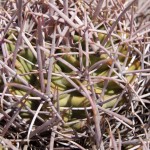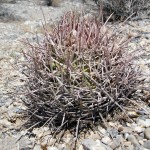(Photograph: Echinocactus polycephalus xeranthemoides, Nancy Hussey)
Introduction
Echinocactus has had a confused history as a genus. Hundreds of plant names have been placed into the genus, which was established in 1827. After lots of revisions the genus now has five or six species; several are found in Mexico only.
The Details
E. polycephalus is a common plant in some parts of the Mojave Desert and south. There are two types, varieties or subspecies depending upon how you look at it. Polycephalus means “many heads” referring to the branching habit of the cactus; it is unusual for plants in the genus to have multiple stems.
E. polycephalus polycephalus (EPP) is widespread from Clark County in Nevada, into the Mojave Desert of California, and into the Sonoran Desert. E. polycephalus xeranthemoides (EPX) grows in northern Arizona near the Grand Canyon, from about Meadview to the Painted Cliffs. EPP grows at lower elevations (below 2,500 ft), whereas EPX grows from about 3,000 ft to over 4,500 ft. At the lower elevations EPP may receive only 5 inches of rain per year, on average.
EPP can branch to make 25 stems, whereas EPX seldom makes more than a dozen and may form a solitary barrel. EPX is a taller plant, large clumps can be over 2-ft tall. Both have wonderful seed pods that are densely covered in white hair. The hair is so dense that a common name for the species is cotton top. Both have nail-hard curved spines that sometimes obscure the green stem.
Additional Reading: Candy Barrel Cactus







I have seed from E. xeranthemoides from a 5,000′ locale in Coconino County and would be glad to share with anyone who can grow it outdoors in the western US. The seeds germinate at high temperatures (90+) in high humidity. I have only seen these plants for sale in Europe on grafts and have never been able to re-root cuttings. E. xeranthemoides grows in very cold locations along the north and south rims of the Grand Canyon so should be hardy at least to sunny zone 6 western locations. E-mail me if you would like to try some seed.
Hi Rod,
Thanks for your generous offer. I hope you get some takers.
Joe
A great plant, and the first time I was wowed by them was E of Independence CA, very Mojave, except according to the maps! It wasdotting a gorgeous curved bajada.
In the garden its picky and in need of sharp drainage…mine rotted one slightly wet but mild winter…in Albuquerque, on well-draining, gravelly soils in full sun. That should tell of how sensitive it is, given everything it should have wanted.